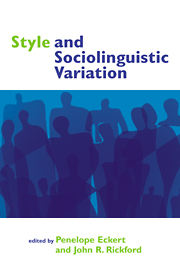Book contents
- Frontmatter
- Contents
- List of figures
- List of tables
- List of contributors
- Acknowledgments
- Introduction: John R. Rickford and Penelope Eckert
- Part I Anthropological approaches
- 1 “Style” as distinctiveness: the culture and ideology of linguistic differentiation
- 2 Variety, style-shifting, and ideology
- 3 The ethnography of genre in a Mexican market: form, function, variation
- 4 The question of genre
- Part 2 Attention paid to speech
- Part 3 Audience design and self-identification
- Part 4 Functionally motivated situational variation
- References
- Index
3 - The ethnography of genre in a Mexican market: form, function, variation
Published online by Cambridge University Press: 07 December 2009
- Frontmatter
- Contents
- List of figures
- List of tables
- List of contributors
- Acknowledgments
- Introduction: John R. Rickford and Penelope Eckert
- Part I Anthropological approaches
- 1 “Style” as distinctiveness: the culture and ideology of linguistic differentiation
- 2 Variety, style-shifting, and ideology
- 3 The ethnography of genre in a Mexican market: form, function, variation
- 4 The question of genre
- Part 2 Attention paid to speech
- Part 3 Audience design and self-identification
- Part 4 Functionally motivated situational variation
- References
- Index
Summary
Introduction: genre in practice
Over the past several years, the concept of genre has made a hesitant entry onto the stage of style- and language-variation studies (e.g., Biber 1988, Biber and Finegan 1989, Ferguson 1994), though it has not as yet been granted anything more than a bit part. One apparent reason why genre has not graduated to a larger role in this line of inquiry is that its use in the computerized language corpora that have carried it onto the stage has been largely ad hoc, deriving for the most part from lay usage and lacking in analytical rigor. Another problem, in broader scope, is that the concept of genre resists disciplinary divisions of intellectual labor, which makes it difficult to domesticate to increasingly specialized scholarly theory and practice. But there is a deeper problem as well. To bring it to the fore, let me turn to one of the charter documents for the workshop on which this volume is based, Douglas Biber and Edward Finegan's recent collection of essays on Sociolinguistic Perspectives on Register (1994). In one of the framing essays of that collection, Charles Ferguson sets out the following “basic working assumption implicit in sociolinguistic study of genre variation”:
A message type that recurs regularly in a community (in terms of semantic content, participants, occasions of use, and so on) will tend over time to develop an identifying internal structure, differentiated from other message types in the repertoire of the community.
(1994; italics in the original)In this formulation, genre represents a framework for discrimination among conventionalized message types on the basis of differential, mutually contrastive internal structures.
- Type
- Chapter
- Information
- Style and Sociolinguistic Variation , pp. 57 - 77Publisher: Cambridge University PressPrint publication year: 2002
- 4
- Cited by



